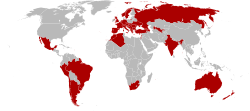International Organisation of Vine and Wine
Organisation Internationale de la vigne et du vin | |
 Member states as of 2011 | |
| Abbreviation | OIV |
|---|---|
| Predecessor | International Vine and Wine Office |
| Formation | January 1, 2004 |
| Type | Intergovernmental organisation |
| Headquarters | 12 Parvis de l'Unesco, Dijon, France |
| Fields | Winemaking, viticulture |
Membership | 49 states |
Official languages |
|
Director General | Pau Roca |
Main organ | OIV General Assembly |
| Website | www |
The International Organisation of Vine and Wine (French: Organisation Internationale de la vigne et du vin; OIV) is an intergovernmental organization which deals with technical and scientific aspects of viticulture and winemaking.[1] The field of OIV includes grape production for all purposes, i.e. not just wine, but also table grapes and raisin production.
One of the activities of OIV is the compilation of global statistics within its field.
OIV is based in Dijon, and had 49 member states as of 2022.[2][3]
History
The earliest forerunners of the OIV are the international conferences held as a reaction to the 19th century phylloxera epidemic, with the five-nation Montpellier Congress held between 26 and 30 October 1874 being the foremost among these.[4] The idea of an international organization came up several times during the coming decades, and finally, on 29 November 1924, eight nations signed an agreement concerned with the creation of an International Wine Office (Office international du vin, OIV) in Paris. After that the agreement went back to nations for ratification. The first working session was held at Salon de l’Horloge on 3 December 1927. On 4 September 1958, the organization's name was changed to the International Vine and Wine Office (Office International de la Vigne et du Vin).
The current International Organisation of Vine and Wine was established following a 35-nation agreement on 3 April 2001, and replaced the International Vine and Wine Office. This agreement went into effect on 1 January 2004.[3]
Member states
 Albania
Albania Algeria
Algeria Argentina
Argentina Armenia
Armenia Australia
Australia- {{country data Austria}srael|flag/core|name=Austria}srael|variant=|size=}}
 Italy
Italy Lebanon
Lebanon Luxemburg
Luxemburg North Macedonia
North Macedonia Malta
Malta Mexico
Mexico Moldova
Moldova Montenegro
Montenegro Morocco
Morocco Netherlands
Netherlands New Zealand
New Zealand Norway
Norway Peru
Peru Portugal
Portugal Romania
Romania Russia
Russia Serbia
Serbia Slovakia
Slovakia Slovenia
Slovenia South Africa
South Africa Spain
Spain Sweden
Sweden Switzerland
Switzerland Turkey
Turkey Ukraine[2][5]
Ukraine[2][5] Uruguay
Uruguay Uzbekistan
Uzbekistan United Kingdom
United Kingdom
Scientific wine color determination
The International Organisation of Vine and Wine provides methods to assess the color of a wine using a spectrophotometer and the calculation of indices in the Lab color space.[6]
Resolutions
In 2013, the OIV took a resolution which "recommends obtaining and developing new cultivars which carry multiple resistance loci [...] to lower the risk of selection and of development of more aggressive pathogen strains", especially for downy and powdery mildew.[7]
References
- ^ OIV - Presentation Archived 2016-01-28 at the Wayback Machine, accessed on March 3, 2009
- ^ a b "Ukraine, new OIV Member State". International Organisation of Vine and Wine. 2022-10-27. Retrieved 2022-10-29.
- ^ a b OIV members Archived 2015-09-24 at the Wayback Machine, accessed on December 1st, 2011
- ^ OIV - Background Archived 2016-01-29 at the Wayback Machine, accessed on March 3, 2009
- ^ "Після 14-річної перерви Україна повертається до Міжнародної організації виноробства". Економічна правда (in Ukrainian). 2022-10-27. Retrieved 2022-10-27.
- ^ CIELab Color Space Archived 2011-06-08 at the Wayback Machine
- ^ Federico Castelluci, General Director of the OIV, Secretary of the General Assembly (2013-06-07). "Resolution OIV-VITI 515-2013: Stability of disease resistance in new cultivars by combining resistance loci" (PDF). oiv.int/. Archived from the original (PDF) on 2014-10-25. Retrieved 2014-10-25.
{{cite web}}: CS1 maint: multiple names: authors list (link)
